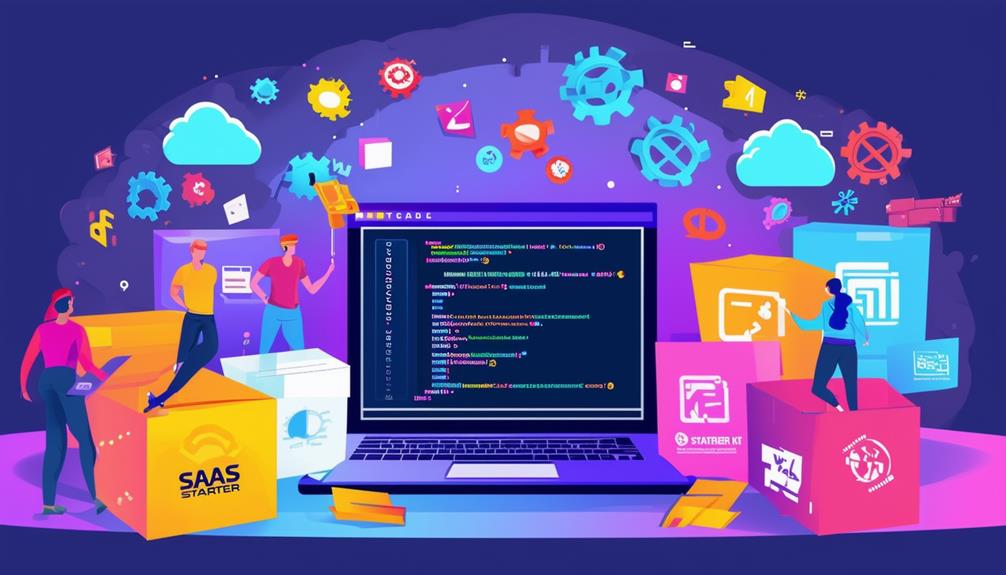You’ve likely heard about SaaS boilerplates, but do you know just how much they can transform your development process? These pre-built templates offer a wealth of benefits that can save you time, money, and headaches. From rapid deployment to enhanced security features, SaaS boilerplates are changing the game for developers and businesses alike. They’re not just a trend; they’re becoming an essential tool in the fast-paced world of software development. But what exactly are these benefits, and how can they give you a competitive edge? Let’s explore the top 10 advantages that might just revolutionize your approach to software creation.
Rapid Development and Deployment
Why spend months building your SaaS from scratch when you can leverage boilerplates to accelerate your development process?
SaaS boilerplates offer a significant advantage in rapid development and deployment, allowing you to launch your product faster and more efficiently. With pre-built components and structures, you’ll reduce development time by up to 60%.
These boilerplates often include essential features like user authentication, database integration, and basic UI elements, saving you weeks of coding. You’ll also benefit from tried-and-tested architectures, minimizing the risk of structural issues down the line.
Deployment becomes a breeze, too. Many SaaS boilerplates come with pre-configured deployment scripts and cloud-ready setups. This means you can go from development to production in hours, not days.
Statistics show that companies using boilerplates can reduce their time-to-market by an average of 40%.
Moreover, you’ll have more time to focus on your unique value proposition. Instead of reinventing the wheel with basic functionalities, you can dedicate resources to developing the features that set your SaaS apart.
This strategic advantage can be vital in today’s competitive market, where being first can often mean the difference between success and obscurity.
Cost-Effective Solution
When it comes to launching a SaaS product, using boilerplates isn’t just faster—it’s also a smart financial move that can save you thousands of dollars in development costs. By leveraging pre-built components and structures, you’re fundamentally cutting down on the hours your development team needs to invest in creating everything from scratch.
Consider this: the average hourly rate for a software developer in the US is $50-$100. A typical SaaS project can take 3-6 months to build from the ground up. With a boilerplate, you can potentially reduce that time by 30-50%, translating to significant cost savings. You’re not just saving on developer salaries, but also on infrastructure setup, testing, and initial deployment costs.
Moreover, boilerplates often come with built-in best practices for scalability and security. This means you’re less likely to face costly redesigns or security breaches down the line. By starting with a solid foundation, you’re investing in your product’s long-term financial health.
Scalability and Flexibility
In the world of SaaS, your ability to scale up and adapt to changing market demands can make or break your success. SaaS boilerplates offer unparalleled scalability and flexibility, empowering you to grow your business without the headaches of traditional software development.
With a SaaS boilerplate, you’re not locked into a rigid structure. You can easily add new features, modify existing ones, or even pivot your entire business model. This adaptability is essential in today’s fast-paced tech landscape, where user needs and market trends can shift overnight.
Research shows that companies using SaaS solutions grow 19.3% faster than those relying on traditional software. Why? Because SaaS boilerplates allow you to scale your infrastructure on-demand. As your user base expands, you can effortlessly increase your server capacity, database resources, and processing power.
Moreover, you’ll benefit from built-in multi-tenancy capabilities. This means you can serve multiple clients from a single instance of your application, drastically reducing operational costs as you scale.
With 73% of organizations planning to make all their systems SaaS by 2023, embracing this flexibility now can give you a significant competitive edge.
Consistent Code Structure
While scalability and flexibility are key advantages, you’ll find that consistent code structure is another major benefit of using SaaS boilerplates. When you adopt a boilerplate, you’re embracing a standardized approach to organizing your codebase. This consistency can remarkably boost your team’s productivity and code quality.
With a well-structured boilerplate, you’ll notice that file organization, naming conventions, and coding patterns are already established. This means you and your team won’t waste time debating where to place new files or how to name functions. Instead, you can focus on building features and solving business problems.
Consistent code structure also makes onboarding new developers easier. They can quickly familiarize themselves with the project layout and start contributing sooner. Furthermore, it enhances code maintainability. When every project follows the same structure, you’ll find it simpler to navigate, debug, and update code across different SaaS applications.
Studies show that teams using consistent code structures can reduce development time by up to 30% and decrease bug rates by 25%. By leveraging SaaS boilerplates, you’re not just saving time; you’re also improving your software’s overall quality and longevity.
Enhanced Security Features
Security stands as a cornerstone benefit of SaaS boilerplates, offering robust protection measures right out of the box. When you use a well-designed boilerplate, you’re inheriting industry-standard security practices that have been vetted and refined over time. These often include built-in authentication systems, data encryption protocols, and secure API integrations.
You’ll find that many SaaS boilerplates come with pre-configured security headers, CSRF protection, and XSS prevention mechanisms. They frequently incorporate OAuth 2.0 or JWT for secure user authentication, reducing the risk of unauthorized access. Additionally, you’ll benefit from automatic security updates, as most boilerplates are actively maintained by their communities.
Database security is another area where boilerplates excel. They typically implement best practices for secure connections, query parameterization to prevent SQL injection attacks, and proper data sanitization. Some even offer built-in support for compliance standards like GDPR or HIPAA.
Simplified Maintenance and Updates
Moving beyond security, you’ll find that SaaS boilerplates greatly streamline your maintenance and update processes. These pre-built frameworks come with automated update mechanisms, ensuring your software stays current without manual intervention. You’ll spend less time on routine maintenance tasks and more on developing core features.
SaaS boilerplates often include centralized update management systems. This means you can push updates to all your users simultaneously, reducing version fragmentation and support complexities. Studies show that businesses using SaaS boilerplates can reduce their maintenance time by up to 40%.
Moreover, these boilerplates are designed with scalability in mind. As your user base grows, you won’t need to overhaul your entire system. The built-in scalability features allow for seamless expansion, saving you time and resources in the long run.
You’ll also benefit from community-driven improvements. Many SaaS boilerplates have active developer communities that contribute bug fixes and feature enhancements. This collaborative approach means you’re not shouldering the entire burden of maintenance alone. By leveraging these community contributions, you can keep your SaaS product cutting-edge with minimal effort on your part.
Improved Team Collaboration
SaaS boilerplates revolutionize team collaboration, offering built-in tools and workflows that streamline communication and project management across your organization. These pre-configured solutions provide a unified platform where team members can seamlessly interact, share information, and track progress in real-time.
With SaaS boilerplates, you’ll find integrated features like task management boards, shared calendars, and document collaboration tools. These elements enable your team to work more efficiently, reducing the need for multiple disparate systems. Studies show that companies using integrated collaboration tools experience a 30% increase in productivity.
You’ll also benefit from standardized processes and templates, ensuring consistency across projects and departments. This uniformity can lead to a 25% reduction in onboarding time for new team members. Additionally, many SaaS boilerplates offer role-based access controls, allowing you to manage permissions and information sharing effectively.
The cloud-based nature of these solutions means your team can collaborate from anywhere, at any time. This flexibility has become essential, with 58% of workers now preferring hybrid work models. By implementing a SaaS boilerplate, you’re not just improving collaboration; you’re future-proofing your organization’s workflow in an increasingly digital world.
Integration With Popular Tools
Seamless integration with popular tools is a cornerstone of SaaS boilerplates, offering you a streamlined workflow that connects your existing tech stack with minimal friction. These boilerplates are designed to work harmoniously with widely-used platforms and services, saving you time and effort in the development process.
You’ll find pre-built integrations for essential tools like GitHub, Slack, and Jira, allowing for smooth version control, team communication, and project management. Many SaaS boilerplates also support popular cloud providers such as AWS, Google Cloud, and Azure, enabling easy deployment and scalability.
Analytics tools like Google Analytics and Mixpanel are often incorporated, giving you immediate access to valuable user data. Payment gateways like Stripe and PayPal are typically included, simplifying the process of setting up subscription models and handling transactions.
Customization Options
While pre-built integrations are valuable, how can you tailor a SaaS boilerplate to fit your unique business needs? The answer lies in the customization options that many SaaS boilerplates offer. These options allow you to modify the core functionality, user interface, and branding elements to align with your specific requirements.
Most SaaS boilerplates provide configurable settings that you can adjust without diving into the code. You’ll often find options to customize colors, fonts, logos, and layout elements.
For more advanced customization, you can typically access and modify the source code directly. This flexibility enables you to add new features, alter existing ones, or integrate proprietary technologies.
Some boilerplates offer modular architectures, allowing you to pick and choose which components to include in your final product. This approach can help you streamline your SaaS application and reduce bloat.
Additionally, many boilerplates support theming systems, enabling you to create multiple visual styles for different client segments or white-label solutions.
Faster Time-to-Market
Speed is the name of the game when you’re launching a new SaaS product, and boilerplates can greatly accelerate your time-to-market. By leveraging pre-built components and structures, you’ll slash development time considerably. Studies show that using boilerplates can reduce project timelines by up to 40%, allowing you to capitalize on market opportunities faster.
With a SaaS boilerplate, you’re not starting from scratch. You’ll have a robust foundation that includes essential features like user authentication, payment processing, and basic UI components. This means you can focus on developing your unique value proposition instead of reinventing the wheel.
Boilerplates also come with pre-configured deployment pipelines, streamlining the launch process. You’ll benefit from automated testing and continuous integration setups, reducing the risk of delays due to technical issues.
Moreover, using a boilerplate allows for rapid prototyping. You can quickly create a minimum viable product (MVP) to test your concept with real users. This iterative approach enables you to gather valuable feedback and make necessary adjustments before full-scale launch, ultimately leading to a more successful product rollout and a competitive edge in the fast-paced SaaS market.
To Wrap Up
You’ll find SaaS boilerplates offer a wealth of benefits for your software projects. They’ll slash development time, cut costs, and boost your team’s productivity.
With built-in security, scalability, and integration features, you’re set for future growth. Don’t overlook the consistent code structure and customization options that’ll make your life easier.
By leveraging these powerful tools, you’ll get your product to market faster and stay ahead of the competition. It’s time to embrace SaaS boilerplates and revolutionize your development process.






